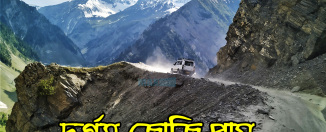Mythological Origin of Dal-Lake and Kashmir Valley in India
Mythologies are wonderful ancient stories mostly involving God, Goddess and of course Demons. In India, mythological books are known as Puran (Purana means Old). There are many Purans written at different times. One such Puran is “Nilmata Puran” which was written probably between 6th and 7th century A.D. In Nilmata Puran there are many beautiful mythologies of Kashmir. It is worth mentioning here that Nilmata Puran is not only a mythological manuscript but also a valuable source of ancient history of Kashmir. Well, let’s flip through the pages of this manuscript to know the mythological explanation of origin of Dal-Lake and entire Kashmir Valley.
Mythological explanation of origin of Dal-Lake and Kashmir Valley:
The entire Kashmir Valley was surrounded by high mountains. In the Ice age all the mountains and the entire valley was covered with ice. At the end of the Ice Age as ice started to melt, a huge lake was created in the valley. The lake was called Satisar (Sati the Daughter of the mighty Himalayas and Sar means Lake). Sati is also known as Parvati because she was daughter of the “Himalaya Parvat” (“Parvat” means Mountain). She was the protector of the lake and used to enjoy water-sports with her friends at this lake.
The Naga Kingdom was spread along the banks of the Satisar Lake. The Naga kings were worshiper of snake (Naga means Snake). After Parvati was grown up she was married to Lord Shiva and the couple started to live at holy Kailash Mountain which is the permanent adobe of Lord Shiva.
Satisar Lake became unguarded. Utilizing this opportunity, a demon named Jaladvhaba took control of the Satisar Lake and started to tyrannize the people of Naga kingdom who lived around the lake.
Jaladvhaba was immensely powerful by the boon of Lord Bhrambha. The Naga King Neelnaga was unable to control Jaladvhaba.
Worried king NeelNaga complained to his father and the great sage Kashyapa about Jaladbhava. Kashyapa further escalated the complaint to Lord Shiva.
Lord Shiva immediately came to Satisar with his wife Parvati to punish the outrageous demon Jaladbvava. Seeing furious Lord Shiva, Jaladbhava hide himself in the water of the lake. Lord Shiva threw his trishul (trident) to kill him but it missed the demon and crashed the western banks of the Satisar. All water of the lake drained out through the crack.
Jaladbhava had no place to hide himself. Seeing the demon Parvati rolled down a big stone and killed the demon. Again peace prevailed in the Kingdom.
After all the water of the Satisar Lake drained out there arose a beautiful valley. The Nagas named the valley ” Kashyapamar” after their father and great sage Kashyap. Later “Kashyapmaar” became “Kashmar” and then “Kashmir”.
Still some water that remained in some deep pockets became lakes in the Kashmir Valley. Thus Dal-Lake was one such deep area at the bottom of Satisar Lake.
Geology supports Mythology:
Geologists say that entire Kashmir Valley was under water and the approximate size of the vast water body was 5600 square kilometer and average depth was 600 meter. During creation of the Himalayas due to earthquake all water of the lake drained through the “Baramula Fault” located at the western end of the valley (the trident of Lord Shiva also hit the western bank of Satisar Lake).

